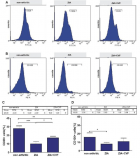Abstract
Research Article
Melaleuca Essential Oil (Melaleuca alternifolia cheel) in the Control of Beans Diseases
Matthieu Octaveus*, Gilmar Franzener and Lisandro Tomas da Silva Bonome
Published: 12 July, 2024 | Volume 8 - Issue 2 | Pages: 100-109
Bean cultivation is vital to the global food and economy, especially in Brazil. Facing challenges from diseases that affect production, it is crucial to seek new strategies to maintain productivity and sustainability. Melaleuca alternifolia, known as the tea tree due to its medicinal properties, has little explored potential in controlling diseases in bean plants. The objective of this work was to evaluate the effectiveness of tea tree essential oil in controlling diseases in bean cultivation. In vitro tests were carried out to evaluate bacterial growth, at concentrations of (0.0%, 0.05%, 0.1%, 0.5%, 1% and 2%). And antibiogram with the bacteria Xanthomonas axonopodis pv. phaseoli, in different concentrations (0.0%, 0.05%, 0.1%, 0.5%, 1%, 2% and 3%). For the fungus Pseudocercospora griseola, sporulation tests were carried out, using direct and indirect methods, at concentrations of (0.0%, 0.05%, 0.1%, 0.5%, 1%, 2%, and 3%). Furthermore, for the fungus Colletotrichum lindemuthianum, mycelial growth tests were carried out with the same concentrations. The experiments took place in vivo, with a completely randomized statistical design, involving five replications per treatment and concentrations varying from (0.0%, 0.05%, 0.1%, 0.5%, 1% and 2%). Disease incidence was assessed using a diagrammatic scale, disease severity, Area under the Disease Progress Curve (AACPD) and Area under the Incidence Progress Curve (AACPI). Melaleuca Essential Oil (EO) inhibited the development of fungi and bacteria in in vitro tests starting at 0.5%. In vivo, Melaleuca Essential Oil (EO) showed a significant reduction in the incidence and severity of the disease from 0.5% in both fungi and bacteria. Melaleuca EO can be an effective alternative for disease control in bean cultivation.
Read Full Article HTML DOI: 10.29328/journal.jpsp.1001140 Cite this Article Read Full Article PDF
Keywords:
Plant health; Phytopathogens; Antibiogram; Sporulation; Mycelial growth
References
- Assumpção D, Ruiz AMP, Borim FSA. Dietary habits of Brazilian adults according to their status in the labor force. Rev Bras Estud Popul. 2023;40:1-16.
- Navarini L, Corte GD, Debona D, Gulart C, Favera DD, Balardin RS. Action of acibenzolar-S-methyl isolated and in combination with fungicides in the management of diseases in bean crop. Arq Inst Biol Sao Paulo. 2009;76(4):735-739. Available from: https://www.scielo.br/j/aib/a/vgV5XXqPWxrqXs5LHsSygsv/?lang=pt
- Dutra RMS, Souza MMO. Green revolution and the evolution of pesticides consumption. Braz Savanna Soc Nat Uberlândia. 2017;29(3):473-488.
- Pedro EADS, Harakava R, Lucon CMM, Guzzo SD. Promotion of bean growth and control of anthracnose by Trichoderma spp. Pesq Agropec Bras. 2012;47(11):1589-1595. Available from: https://www.scienceopen.com/document?vid=a06c485e-34e7-4d82-82a9-415fb19e9fcc
- Tsutsumi CY, Bulegon LG, Piano JT. Bean genetic improvement: advances, perspectives and new studies at the national level. Nativa Sinop. 2015;3(3):217-223.
- Nascimento DM, Santos PL, Ribeiro-Junior MR, Sartori MMP, Kronka AZ. Essential oils control anthracnose in pepper seeds. Res Soc Dev. 2020;9(10).
- National Supply Company. Available at: https://www.canalrural.com.br/radar/feijao-conab-projeta-safra-brasileira-de-2982-milhoes-de-toneladas-em-2022-23/
- Siqueira ITDD, Cruz LR, Souza-Motta CMD, Medeiros EVD, Moreira KA. Induction of resistance by acibenzolar-S-methyl in cowpea to control anthracnose. Summa Phytopathol Botucatu. 2019;45(1):76-82. Available from: https://www.scielo.br/j/sp/a/LXWHv4DGmPhBgGWthNtw58R/?lang=pt
- Alves JVS, Coelho MP, Bertan FL, Silva DC, Silva VC, Chiamulera MT, Carvalho IF, Silva CA, Araújo DV. Induction of resistance to Colletotrichum sp. in Heliconia psittacorum x sparthocircinata cv. Golden Torch grown in shaded and full sun conditions. Summa Phytopathol Botucatu. 2020;46(4):320-326. Available from: https://www.scielo.br/j/sp/a/dSrssNWWLhVYyPNLqJQNP9b/?lang=pt
- Telaxka FJ, Jaski JM, Scheffer DC, Gebauer JT. Aqueous and fermented extracts of wild tobacco (Solanum mauritianum Scop) in the protection of bean plants (Phaseolus vulgaris L.) against common bacterial blight. Rev Bras Agropec Sustentável (RBAS). 2018;8(3):81-90.
- Conduta NS, Silva MTR E, Rinaldi LK, Dias-Arieira CR. Interaction between resistance inducer and micronutrients on the control of root-lesion nematode and the development of soybean plants. Rev Caatinga. 2020;33(3):591-598. Available from: https://www.scielo.br/j/rcaat/a/93BtZGfVPZRn3qpTWN5L5Wt/?lang=en
- Azevedo CVG, Ribeiro T, Silva DA, Carbonell SAM, Chiorato AF. Adaptability, stability and resistance to pathogens in bean genotypes. Pesq Agropec Bras. 2015;50(10):912-922. Available from: https://www.scielo.br/j/pab/a/sRh9ZfKbwYHzQXQq5G9HdwM/?lang=pt
- Schmidlt ER, Amaral JAT, Pratissoli D, dos Reis EF. Influence of artificial defoliation to simulate losses in bean production (Phaseolus vulgaris L. cv. Xamego). Arq Inst Biol Sao Paulo. 2010;77(3):457-463. Available from: https://www.scielo.br/j/aib/a/QqzFXL6Q5nN77NBPfpHMqSR/?lang=pt
- Viecelli CA, Stangarlin JR, Kuhn OJ, Schwan-Estrada KRF. Induction of resistance in bean to angular spot by extracts of mycelium of Pycnoporus sanguineus. Summa Phytopathol. 2010;36(1):73-80. Available from: https://www.scielo.br/j/sp/a/NQNJJKXXQnmJCn5ZJwWWCfb/?lang=pt
- Guazina RA, Theodoro GDF. In vitro action of silicon sources on isolates of Curtobacterium flaccumfaciens pv. flaccumfaciens. Summa Phytopathol. 2017;43(4):310-315. Available from: https://www.scielo.br/j/sp/a/KgxZ3YBvHSKr3TFVYYcgqtL/?lang=pt
- Viecelli CA, Stangarlin JR, Kuhn OJ, Schwan-Estrada KRF. Induction of resistance in bean by culture filtrate of Pycnoporus sanguineus against Pseudocercospora griseola. Trop Plant Pathol. 2009;34(2):1-10. Available from: https://www.scielo.br/j/tpp/a/cKNtwLFhKBXW4CwjFnS3sfJ/?lang=pt
- Toillier SL, Iurkiv L, Meinerz CC, Baldo M, Viecelli CA, Kuhn OJ, Schwan-Estrada KRF, Stangarlin JR. Control of common bacterial blight (Xanthomonas axonopodis pv. phaseoli) and biochemical changes in beans induced by Pycnoporus sanguineus. Arq Inst Biol Sao Paulo. 2010;77(1):99-110. Available from: https://www.scielo.br/j/aib/a/ZNtBY6Yjr7HgVgDRFrDmZGN/abstract/?lang=en
- Bizzo HR, Hovell AMC, Rezende CM. Essential oils in Brazil: general aspects, development and perspectives. Quim Nova. 2009;32(3):588-594. Available from: https://www.scielo.br/j/qn/a/QwJBsdNzGmZSq4jKmhwVDnJ/?lang=pt
- Cunha JPAR, Silva LL, Boller W, Rodrigues JF. Aerial and ground application of fungicide for the control of corn diseases. Rev Ciênc Agron. 2010;41(3):366-372. Available from: https://www.scielo.br/j/rca/a/Br6kwydsVrNGB5p3FTrgTSp/?lang=pt
- Castro CD, Silva MLD, Pinheiro AL, Jacovine LAG. Economic analysis of the cultivation and extraction of essential oil from Melaleuca alternifolia Cheel. R Árvore. 2005;29(2):241-249. Available from: https://www.scielo.br/j/rarv/a/Qk4tpBRMcWgdjqwSVtp6kKx/?lang=pt
- Chagas ACS, Passos MWM, Prates HT, Leite RC, Furlong J. Acaricidal effect of essential oils and emulsifiable concentrates of Eucalyptus spp. on Boophilus microplus. Braz J Vet Res Anim Sci. 2002;39(5):247-253. Available from: https://www.revistas.usp.br/bjvras/article/view/5956
- Barros FC, Sagata E, Ferreira LCC, Juliatti FC. Induction of resistance in plants against phytopathogens. Biosci J. 2010;26(2):231-239. Available from: https://www.researchgate.net/publication/289151111_Induction_of_resistance_in_plants_against_phytopathogens
- Freitas MB, Stadnik MJ. Effectiveness of formulas based on ulvan in inducing resistance in Phaseolus vulgaris against Colletotrichum lindemuthianum. Trop Plant Pathol. 2011;36(1):1-5. Available from: https://www.scielo.br/j/tpp/a/YqRwNkJ67KKSB7PnKf8DkcR/abstract/?lang=en
- Souza AD, Roggerio TU, Furlan MR, Aoyama EM. Tea tree oil (Melaleuca alternifolia Maiden & Betche, Cheel) in control of Cercospora beticola Sacc. on Beet. Rev Bras Plantas Med. 2015;17(4 Suppl 3):1078-1082. doi:10.1590/1983-084X/14_042. Available from: https://www.scielo.br/j/rbpm/a/tYtkGDfTvPyKnqw48zKcJYp/abstract/?lang=en&format=html
- Simões RP, Groppo FC, Sartorato A, Fiol FDSD, Mattos Filho TD, Ramaccia to JC, Rodrigues MVN. Effect of Melaleuca alternifolia oil on staphylococcal infection. Lecta Magazine. 2002;(20):143-152.
- Baldoux D. O Grande Manual da Aromaterapia de Dominique Baudaux. Belo Horizonte: Editora Laszlo; 2018.
- Pathmanathan S, Uthayasooriyan M, Ravimannan N, Sathyaruba S. Formulation of alternative culture media for bacterial and fungal growth. Der Pharmacia Lettre. 2016;8(1):431-436. Available from: http://192.248.56.27:8080/jspui/handle/123456789/3910
- Santos TD, Furlong EB. Identification of common bean resistance sources to the phytopathogen Sclerotinia sclerotiorum. Peer Review. 2023;5(7).
- Feijó FM, Silva WC, Assunção IP, Martins RB, Michereff SJ, Lima GSA. Diagrammatic scale analysis for evaluation of the severity of anthracnose in fava bean pods. Cienc Agric. 2017;15(1):43-51. Available from: https://www.seer.ufal.br/index.php/revistacienciaagricola/article/view/2677
- Buffara CRS, Angelotti F, Bogo RAVA, Bem DJTB. Elaboration and validation of a diagrammatic scale to assess downy mildew severity in grapevine. Cienc Rural. 2013;43(10):1735-1743.
- Barbosa CCF. Evaluation of severity in relation to resistance to common bacterial blight in a panel of carioca beans. Universidade Federal de São Carlos Centro de Ciências Agrárias; 2021;1-30.
- Ferreira DF. SISVAR: System for analysis of variance for balanced data, version 5.0. Lavras: DEX/UFLA; 2007. CD-ROM. Software.
- Hillen T, Schwan-Estrada KRF, Mesquini RM, Cruz MES, Stangarlin JR, Nozaki M. Antimicrobial activity of essential oils in the control of some fungal phytopathogens in vitro and in seed treatment. Rev Bras Pl Med. 2012;14(3):439-445. Available from: https://www.scielo.br/j/rbpm/a/BFTfgb4MNgYhBv47rkDK8DH/?lang=pt.
- Ramos K, Andreani Junior R, Kozusny-Andreani DI. Essential and vegetable oils in control in vitro de Colletotrichum gloeosporioides. Rev Bras Pl Med. 2016;18(2 Suppl 1):605-612. doi:10.1590/1983-084X/15_192. Available from: https://doi.org/10.1590/1983-084X/15_192.
- Correa LT, Nicoletti MA, de Amorim CS, da Costa AR, Leoni LAB, Munõz JWP, Fukushima AR. Antimicrobial activity of melaleuca essential oil and its incorporation into a mucocutaneous cream. Rev Fitos. 2020;14(1):26-37. e-ISSN: 2446-4775. Available from: https://www.arca.fiocruz.br/handle/icict/41290.
- Marques EC, Souza DMST, Vilela FF, Teixeira MA. Melaleuca armillaris essential oil as an odor reducer in intestinal ostomy bags: a semi-experimental study. J Sch Nurs Univ São Paulo. 2022;3(2):1-7.
- Martins JAS, Sagata E, Santos VA, Uliatti FC. Evaluation of the effect of Melaleuca alternifolia oil on the in vitro mycelial growth of phytopathogenic fungi. Biosci J. 2010;27(1):49-51. Available from: https://www.researchgate.net/publication/288381092_Evaluation_of_the_effect_of_melaleuca_alternifolia_oil_on_mycelial_growth_of_phytopathogenic_fungi_in_vitro.
- Riccioni L, Orzali L. Activity of tea tree (Melaleuca alternifolia, Cheel) and thyme (Thymus vulgaris, Linnaeus.) essential oils against some pathogenic seed borne fungi. J Essent Oil Res. 2011;23(6):43-47. doi:10.1080/10412905.2011.9712280. Available from: https://www.tandfonline.com/doi/abs/10.1080/10412905.2011.9712280
- Nascimento DM, Santos PL, Kronka AZ. Essential oils inhibit Colletotrichum gloeosporioides spore germination. Summa Phytopathol. 2019;45(4):432-433. Available from: https://www.scielo.br/j/sp/a/4cShHVqJy7Sy8vrHzHhrFKx/?lang=en
- Costa ACBP, Teodoro GR, Ferreira TM, Silva FMA, Sônia K. Antifungal activity of Melaleuca alternifolia essential oil on yeasts isolated from HIV positive pregnant women with oral candidiasis. Rev Inst Adolfo Lutz. 2010;1(2):1-5. doi:10.1590/S0100-40422009000300008. Available from: https://doi.org/10.1590/S0100-40422009000300008
- Portella J, Orlandi RC, Almeida J, Koefender J, Schoffel A, Camera JN. Essential oils in vitro control of Sclerotinia sclerotiorum. Rev Thema. 2021;19(3):615-622. Available from: https://periodicos.ifsul.edu.br/index.php/thema/article/view/2367
- Nepomoceno TAR, Pietrobon AJ. Melaleuca alternifolia: A systematic review of Brazilian literature. Rev UNINGÁ Rev. 2020;35(20):1-29. Available from: https://revista.uninga.br/uningareviews/article/view/3409
- Peixinho GDS, Ribeiro VG, Amorim EPDR. Dry Rot Control (Lasiodiplodia theobromae) in bunches of vine cv. Italy for essential oils and chitosan. Summa Phytopathol. 2017;43(1):26-31. Available from: https://www.scielo.br/j/sp/a/DMr98jNwZNgZqRNRcnNvMNk/?lang=pt
- Carvalho Neta RNF, Sousa DBP, Barros MFDS, Nunes KB, Torres HS, et al. Potential uses of essential oils in environmental remediation: A review. Res Soc Dev. 2021;10(7):1-14. Available from: https://www.lareferencia.info/vufind/Record/BR_7a85bc27779b6a1780d4d49624468b55
- Siega TC, Bernardi C, Silva M, Feliceti ML, Rey MS, Mazaro SM. Production of extracellular enzymes of Sclerotic sclerotinia under the effect of essential oils from Casearia sylvestris, Eugenia uniflora and Melaleuca latifolia. Braz J Develop. 2020;6(8):59481-59490. Available from: https://ojs.brazilianjournals.com.br/ojs/index.php/BRJD/article/view/15199/12539
- Ferreira CF, Aoyama EM, Souza AD, Fortes NLP, Furlan MR. Essential oils and eugenol in the “in vitro” control of post-harvest phytopathogenic fungi. Rev Biociências. 2020;26(2):1-12.
- Vishakha K, Das S, Das SK, Banerjee S, Ganguli A. Antibacterial, anti-biofilm, and anti-virulence potential of tea tree oil against leaf blight pathogen Xanthomonas oryzae pv. oryzae instigates disease suppression. Braz J Microbiol. 2022;8(5):19-32. Available from: https://link.springer.com/article/10.1007/s42770-021-00657-2
- Puvača N, Čabarkapa I, Petrović A, Bursić V, Prodanović R, Soleša D, et al. Tea tree (Melaleuca alternifolia) and its essential oil: antimicrobial, antioxidant and acaricidal effects in poultry production. Worlds Poult Sci J. 2019;75:235-246. Available from: https://www.tandfonline.com/doi/full/10.1017/S0043933919000229
- Phongpaichit S, Pujenjob N, Rukachaisirikul V, Ongsakul M. Antifungal activity from leaf extracts of Cassia alata L., Cassia fistula L. and Cassia tora L. Songklanakarin J Sci Technol. 2004;26:741-748. Available from: https://citeseerx.ist.psu.edu/document?repid=rep1&type=pdf&doi=3601805b4385c5a7c487d4cb29aeef84577a7a25
- Hammer KA, Carson CF, Riley TV. Antifungal activity of the components of Melaleuca alternifolia (tea tree) oil. J Appl Microbiol. 2003;95:853-860. Available from: https://academic.oup.com/jambio/article-abstract/95/4/853/6723947
- Russo M, Suraci F, Postorino S, Serra D, Roccotelli A, Agosteo GE. Essential oil chemical composition and antifungal effects on Sclerotium cepivorum of Thymus capitatus wild populations from Calabria, southern Italy. Rev Bras Farmacogn. 2013;23(2):239-248. Available from: https://www.scielo.br/j/rbfar/a/RcLVTxJj3rFgjjrD5YxBwkd/?format=pdf&lang=en
- Quintão CJG. Effect of essential oils on phytopathogenic fungi. IX Scientific Initiation Seminar do IFMG. 2021;1(1):1-5. doi:10.1590/1983-084X/12_170
- Cavalcanti YW, Pérez ALADL, Xavier GDR, Almeida LDFDD. Inhibitory effect of essential oils on root canal microorganisms. Rev Odontol UNESP. 2011;40(5):208-214. Available from: https://www.revodontolunesp.com.br/article/588018ef7f8c9d0a098b4ec9
- Pereira MC, Vilela GR, Costa LMAS, Silva RF, Fernandes AF, et al. Inhibition of fungal development through the use of essential oils for condiments. Ciênc Agrotec. 2006;30(4):731-738. Available from: https://www.scielo.br/j/cagro/a/GttKGg3rYZzzhVBFJ5t9mmb/?lang=pt
- Steffen G, Maldaner J, Steffen R, Missio EL, Mezzomo R. Control of Sclerotinia sclerotiorum and Fusarium sp. with Melaleuca essential oil. Enciclopédia biosfera. 2019;16(30).
- Khalili ST, Mohsenifar A, Beyki M, Zhaveh S, Rahmani-Cherati T, Abdollahi A, et al. Encapsulation of Thyme essential oil in chitosan-benzoic acid nanogel with enhanced antimicrobial activity against Aspergillus flavus. Food Sci Technol. 2015;60(1):502-508.
- Garcia FA, Romeiro RS. Biocontrol of bean spot by bacterial antagonists. Pesq Agropec Bras. 2011;46(12):1603-1608.
- Powers CN, Osier JL, McFeeters RL, Brazell CB, Olsen EL, Moriarity DM, et al. Antifungal and cytotoxic activities of sixty commercially-available essential oils. Molecules. 2018;23(7):1549. Available from: https://www.mdpi.com/1420-3049/23/7/1549
- Barbosa MS, Vieira GHC, Teixeira AV. Biological activity in vitro propolis and essential oils on the Colletotrichum musae isolated in Musa spp. Braz J Med Plants. 2015;17:254-261. br/j/rbpm/a/Sjmr6cLY5TDYZ9S9T5VsNmf/?format=pdf&lang=pt
- Mariano DC, Giebelmeier CG, Albuquerque GDP, Silva CR, Shigueru Okumura RS. Use of oil of Melaleuca alternifolia in the treatment of sunflower seeds. Enciclopédia biosfera. 2014;10(18).
- Mishra S, Singh HB. Biosynthesized silver nanoparticles as a nanoweapon against phytopathogens: exploring their scope and potential in agriculture. Appl Microbiol Biotechnol. 2015;99:1097–1107. Available from: https://link.springer.com/article/10.1007/S00253-014-6296-0
- Ferreira TP, Cid YP, Alves MCC, Santos GCM, Avelar BR, Freitas JP, et al. In vitro Acaricidal Activity of Ocimum gratissimum Essential Oil on Rhipicephalus sanguineus, Amblyomma sculptum and Rhipicephalus microplus Larvae. Rev Virtual Quim. 2019;11(5):1604-1613. Available from: http://static.sites.sbq.org.br/rvq.sbq.org.br/pdf/v11n5a16.pdf
Figures:
Similar Articles
-
Antagonistic features displayed by Plant Growth Promoting Rhizobacteria (PGPR): A ReviewMohsin Tariq*,Muhammad Noman,Temoor Ahmed,Amir Hameed,Natasha Manzoor,Marriam Zafar. Antagonistic features displayed by Plant Growth Promoting Rhizobacteria (PGPR): A Review . . 2017 doi: 10.29328/journal.jpsp.1001004; 1: 038-043
-
Effect of Khaya Senegalensis Bark and Oil on Post-Harvest Fungal Agents of Groundnut Seeds Rot in Adamawa State, NigeriaChannya FK*,Asama P,Anjili SM . Effect of Khaya Senegalensis Bark and Oil on Post-Harvest Fungal Agents of Groundnut Seeds Rot in Adamawa State, Nigeria. . 2019 doi: 10.29328/journal.jpsp.1001035; 3: 076-080
-
Antifungal activity of epecific plant essential oils against fusarium graminearumEmre Yörük*,Esma Özsoy,Buket Kesercan. Antifungal activity of epecific plant essential oils against fusarium graminearum. . 2020 doi: 10.29328/journal.jpsp.1001052; 4: 060-062
-
Characterization and virulence determination of Colletotrichum kahawae isolates from Gidami, Western EthiopiaZenebe W*,Daniel T,Weyessa G. Characterization and virulence determination of Colletotrichum kahawae isolates from Gidami, Western Ethiopia. . 2021 doi: 10.29328/journal.jpsp.1001054; 5: 004-013
-
The use of Bacillus thuringiensis to control plant-parasitic nematodesYolanda Bel,Magda Galeano,Mireya Baños-Salmeron,Baltasar Escriche*. The use of Bacillus thuringiensis to control plant-parasitic nematodes. . 2022 doi: 10.29328/journal.jpsp.1001076; 6: 062-064
-
Mitigation and adaptation to climate change of plant pathogensFrancesco Lops*. Mitigation and adaptation to climate change of plant pathogens. . 2022 doi: 10.29328/journal.jpsp.1001082; 6: 101-102
-
Control of rice bakanae disease by seed dressing with mixed solution of fludioxonil, metalaxyl-M and azoxystrobinDeng Chen,Qi-Juan Hu,Xiao-Feng Chen*. Control of rice bakanae disease by seed dressing with mixed solution of fludioxonil, metalaxyl-M and azoxystrobin. . 2023 doi: 10.29328/journal.jpsp.1001096; 7: 001-007
-
Management of Chocolate Spot Disease in Faba Bean Plants by using Biological Control MeansAhmed MFA*, Salem EA, Mahmoud MA, Shaheen SI. Management of Chocolate Spot Disease in Faba Bean Plants by using Biological Control Means. . 2023 doi: 10.29328/journal.jpsp.1001120; 7: 142-150
-
Melaleuca Essential Oil (Melaleuca alternifolia cheel) in the Control of Beans DiseasesMatthieu Octaveus*, Gilmar Franzener, Lisandro Tomas da Silva Bonome. Melaleuca Essential Oil (Melaleuca alternifolia cheel) in the Control of Beans Diseases. . 2024 doi: 10.29328/journal.jpsp.1001140; 8: 100-109
Recently Viewed
-
Parents’ perception of the school nurse’s roleDiane Gillooly*,Ganga Mahat,Patricia Paradiso. Parents’ perception of the school nurse’s role. J Adv Pediatr Child Health. 2020: doi: 10.29328/journal.japch.1001021; 3: 064-067
-
Plant growth, Yield and Leaf Nutritional value of Jute (Corchorus olitorius L.) as Influenced by Banana Peel levels under Salt Stress conditions in Coastal region of CameroonMathias Julien Hand*,Chimène Fanta Abib,Kingsley Mbi Tabi,Alphonse Ervé Nouck,Libert Brice Tonfack,Victor Désiré Taffouo,Emmanuel Youmbi. Plant growth, Yield and Leaf Nutritional value of Jute (Corchorus olitorius L.) as Influenced by Banana Peel levels under Salt Stress conditions in Coastal region of Cameroon. J Plant Sci Phytopathol. 2024: doi: 10.29328/journal.jpsp.1001145; 8: 131-140
-
Dynamics of Siberian Fir Stands in Forest Ecosystems of Eastern Sayan SpursBazhina Elena Vasil’evna*,Pavel I Aminev. Dynamics of Siberian Fir Stands in Forest Ecosystems of Eastern Sayan Spurs. J Plant Sci Phytopathol. 2024: doi: 10.29328/journal.jpsp.1001146; 8: 141-143
-
Minimising Carbon Footprint in Anaesthesia PracticeNisha Gandhi and Abinav Sarvesh SPS*. Minimising Carbon Footprint in Anaesthesia Practice. Int J Clin Anesth Res. 2024: doi: 10.29328/journal.ijcar.1001025; 8: 005-007
-
Survey of Advanced Image Fusion Techniques for Enhanced Visualization in Cardiovascular Diagnosis and TreatmentGargi J Trivedi*. Survey of Advanced Image Fusion Techniques for Enhanced Visualization in Cardiovascular Diagnosis and Treatment. J Clin Med Exp Images. 2025: doi: 10.29328/journal.jcmei.1001034; 9: 001-009
Most Viewed
-
Evaluation of Biostimulants Based on Recovered Protein Hydrolysates from Animal By-products as Plant Growth EnhancersH Pérez-Aguilar*, M Lacruz-Asaro, F Arán-Ais. Evaluation of Biostimulants Based on Recovered Protein Hydrolysates from Animal By-products as Plant Growth Enhancers. J Plant Sci Phytopathol. 2023 doi: 10.29328/journal.jpsp.1001104; 7: 042-047
-
Sinonasal Myxoma Extending into the Orbit in a 4-Year Old: A Case PresentationJulian A Purrinos*, Ramzi Younis. Sinonasal Myxoma Extending into the Orbit in a 4-Year Old: A Case Presentation. Arch Case Rep. 2024 doi: 10.29328/journal.acr.1001099; 8: 075-077
-
Feasibility study of magnetic sensing for detecting single-neuron action potentialsDenis Tonini,Kai Wu,Renata Saha,Jian-Ping Wang*. Feasibility study of magnetic sensing for detecting single-neuron action potentials. Ann Biomed Sci Eng. 2022 doi: 10.29328/journal.abse.1001018; 6: 019-029
-
Pediatric Dysgerminoma: Unveiling a Rare Ovarian TumorFaten Limaiem*, Khalil Saffar, Ahmed Halouani. Pediatric Dysgerminoma: Unveiling a Rare Ovarian Tumor. Arch Case Rep. 2024 doi: 10.29328/journal.acr.1001087; 8: 010-013
-
Physical activity can change the physiological and psychological circumstances during COVID-19 pandemic: A narrative reviewKhashayar Maroufi*. Physical activity can change the physiological and psychological circumstances during COVID-19 pandemic: A narrative review. J Sports Med Ther. 2021 doi: 10.29328/journal.jsmt.1001051; 6: 001-007

HSPI: We're glad you're here. Please click "create a new Query" if you are a new visitor to our website and need further information from us.
If you are already a member of our network and need to keep track of any developments regarding a question you have already submitted, click "take me to my Query."















































































































































